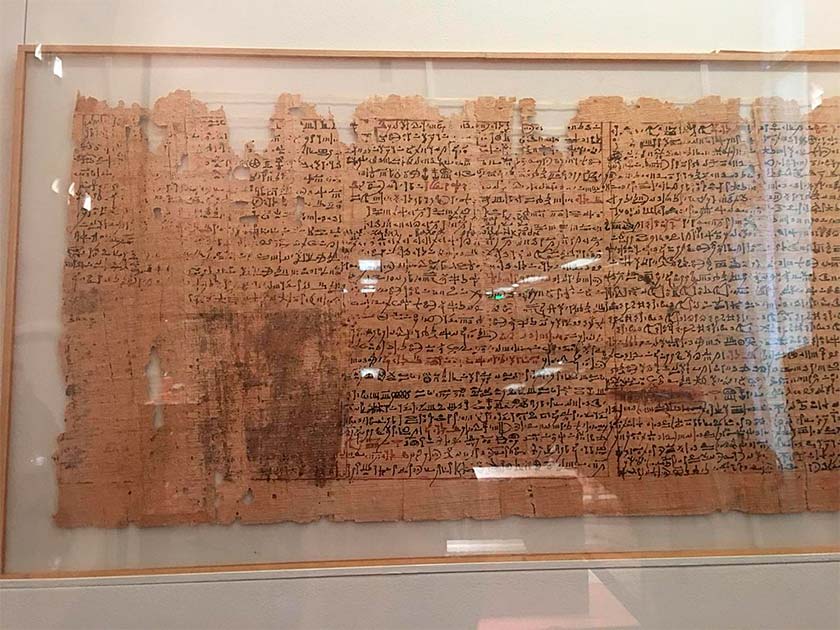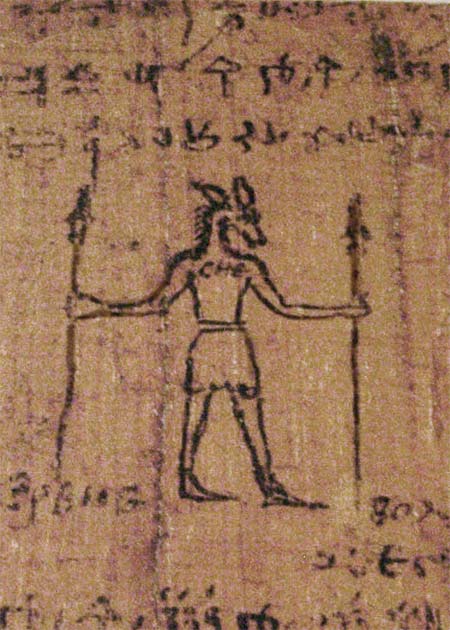Many notable papyri from ancient Egypt provide insight into life at the time. There are papyri filled with medical writings, scientific writings, funeral rites and books about the dead, official documents and myths.

There are the Edwin Smith papyri, the Ebers papyrus, the Turin royal list and the London medical papyrus. And then there are things that teach you magic, like Greek magic papyri. This ancient book of magic and ritual provides readers with knowledge of magic and illustrates the syncretism popular in Greco-Roman Egypt.
The Greek Magic Papyrus
The Greek Magic Papyri (Papyri Graecae Magicae) is a collection of papyrus from ancient Greco-Roman Egypt. The work is mainly written in Ancient Greek, but parts are written in Common and Old Coptic.
The papyrus pages contain lists of rituals, spells, chants, and formulas dating from 100 BC to 400 AD. One of the most famous texts on Greek magic papyrus is the “Liturgy of Mithras”.
The Mithras Liturgy is an invocation to the god Helios Mithras, who is said to reveal the secret of immortality to the individual performing the ritual.Mithras divided seven stages through which the soul must ascend before immortality is revealed.
There are many mysteries surrounding this text because the reasons why these lists of spells and rituals were created over the centuries are unknown to us today. Some scholars believe that Greek magical papyri were part of “secret literature” hidden at a time when magical texts were burned in the early days of Christian book burning. Other scholars believe that the Greek magical papyri were fragments of text created by Egyptian priests in the third or fourth century, rather than an underground secret text.
The existence of Greek magical papyri first became known in the early 19th century, when they were listed on the Egyptian art market as part of antiquities sales. Another part of the papyrus was obtained by French diplomat Jean-François Mimaut and is kept in the French National Library.

Much of the Greek magic papyrus is known as the Anastasi collection. In 1827, a man named Kean from Anastasi bought some papyrus. d’Anastasi claims that he obtained the papyrus while at Thebes (or modern day Luxor) and later sold the pieces to European collectors and institutions such as the Rijksmuseum van Oudheden in the Netherlands, the Staatliche Museen zu Berlin in Germany, the Louvre in France and the British Museum in the UK.
The contents of the Greek magic papyrus show a combination of Egyptian magic and Greco-Roman cult. There is also great syncretism in the papyrus, which shows the mingling and mingling of Greek, Egyptian, and Jewish magical beliefs and rituals.
But the magical Greek papyri are not the only books found from the depths of ancient archives; rather, it is a series of individual texts divided into volumes. Each Greek magical papyrus includes a number of ancient spells, rituals and formulas.
The Greek Magical Papyri includes sections in Demotic and Coptic languages which were stages of the ancient Egyptian language that used hieratic script (cursive rather than pictorial hieroglyphics) and the incorporation of the Greek alphabet and supplemental letters that the Egyptian language borrowed from the Greek language. The Rosetta Stone, discovered in 1799, is written in three scripts: Demotic, the Greek alphabet, and Egyptian hieroglyphs.
The Greek Magical Papyri shows the evolution, influence, and shifts to language occurring in Graeco-Roman Egypt. The text is written in forms of language that could be used by both Greeks and Egyptian healers, ritualists, or mystics. Practical, indeed.
Yes but the Spells?
Like all good spell books, the Greek magical papyrus contained many different spells and rituals that one could perform as well as the ingredients needed to perform the spell. A spell, called “the spell that must be invisibility”, requires interesting ingredients.
First you need to be fat. Don’t worry if this is complicated, as you can substitute night owl eyes, then add a beetle roll and oil from unripe olives. The caster must grind the ingredients until smooth, then apply the mixture all over the body and “say to Helios: ‘I beseech you by your great name, make me invisible, sir. Lord Helios/in the presence of any man until sunset. .’ »
If this spell doesn’t work (can you imagine…?), there is another spell called the “tested invisibility spell” and the This mantra is described as an excellent work. All you need is “monkey eyes or a fierce corpse and a peony plant.” Rub them with lily oil from right to left on the face” to ask the gods Anubis and Osiris for invisibility.
Greek magical papyri say that after casting the spell and rubbing the mixture on your face, you will be invisible for as long as you want.Unfortunately, there are no notes to prove the effectiveness of this spell. Or others.

Many of the spells in the Greek Magical Papyri are incredibly long and very complex. For a spell that is called the “powerful spell of the Bear, which accomplishes anything,” one must “take the fat of a black ass, the fat of a dappled she-goat, the fat of a black bull, and Ethiopian cumin, mix it all together and make an offering to the Bear, having as a phylactery (an amulet box common in Judaism) hairs from the same animals which you have plaited into a cord and are wearing as a diadem around your head. Anoint your lips with the fats, smear your whole body with storax oil (a natural resin derived from the damaged bark of the Liquidambar orientalis Mill plant), and make your petition while holding a single-shooted Egyptian onion. Gird yourself with a palm fiber of a male date palm, kneel down, and speak.”
This long formula is listed in full in the text. The mention of a bear in this spell exemplifies the mixing of Egyptian and Greek knowledge. Ancient Greeks have described bears, but they are not one of the many animals worshiped as part of the Egyptian pantheon, mostly because Ancient Egypt isn’t known for its massive populations of bears. Or bears at all.
Some spells in the Greek Magical Papyri are for medicinal treatment of the ill. There are spells for treating swollen testicles, a cough, migraines, dog bites, removal of poisons, and the spell for removing a bone stuck in the throat.
Other spells are more entertaining than anything. In the Greek Magical Papyri, there are many love spells, spells for attraction, spells to make a woman confess the name of the man she loves, etc. There are spells for “subjugation concerning the mole-[rat],” “cat ritual for many purposes,” “request for a dream oracle,” and a number of spells to cause “evil sleep.”
Top Image: The Greek Magical Papyri contained all sorts of spells for every day tasks. Source: Gasia / Adobe Stock.






